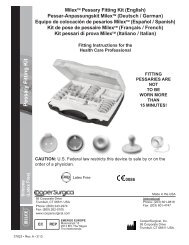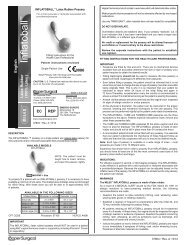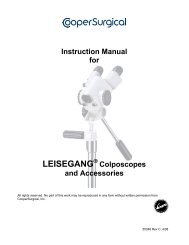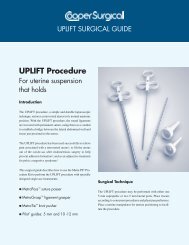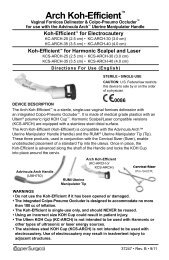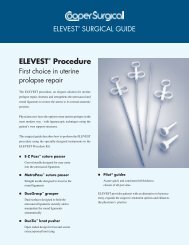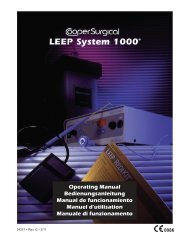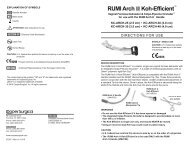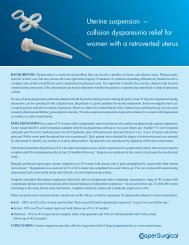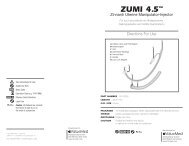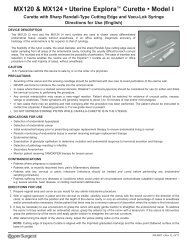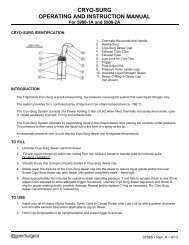LEEP System 1000® Workstation Operating ... - CooperSurgical
LEEP System 1000® Workstation Operating ... - CooperSurgical
LEEP System 1000® Workstation Operating ... - CooperSurgical
Create successful ePaper yourself
Turn your PDF publications into a flip-book with our unique Google optimized e-Paper software.
Section 8<br />
Periodic Safety Checks and Maintenance<br />
8.1 <strong>LEEP</strong> <strong>System</strong> 1000 ® Electrosurgical Generator<br />
The following safety checks should be performed at least every 24 months by a qualified person who has<br />
adequate training, knowledge and practical experience to perform these tests.<br />
• Inspect the equipment and accessories for mechanical and functional damage<br />
• Inspect the relevant safety labels for legibility<br />
• Inspect the fuse to verify compliance with rated current and breaking characteristics<br />
• Inspect acoustical and visual alarms/displays<br />
• Verify that the device functions properly as described in the Directions for Use<br />
• Verify that the device shuts down the applied part circuit if the neutral electrode is disconnected<br />
• Test the protection earth resistance according to IEC 601-1/1988: Limit 0.2 ohm<br />
• Check that the output power is within tolerance versus the output control setting at a specified<br />
load resistance<br />
• Check the power output at full and half setting of the output control over the range of load resistance<br />
as specified in the instructions for use (max. deviation is ± 20%)<br />
• Test the enclosure leakage current according to IEC 601-1/1988: Limit 100µA<br />
• Test the leakage current according to IEC 601-1/1988: Limit 100µA (BF)<br />
• Test the patient leakage current under single fault condition with main voltage on the applied part<br />
according to IEC 601-1/1988: Limit: 5mA (BF)<br />
The leakage current should never exceed the limit. The data should be recorded in an equipment log. If the<br />
device is not functioning properly or fails any of the above tests, the device must be repaired.<br />
8.2 Smoke Evacuator<br />
No maintenance is required during normal operation other than ensuring that ample space is<br />
maintained around the Smoke Evacuator to allow for free air flow and adequate cooling.<br />
Section 9<br />
Safety Circuits<br />
The Electrosurgical Generator is equipped with two safety circuits. The first one checks the Dispersive Patient<br />
Plate connection. The second one turns off the power in case of an internal failure. When activating the<br />
Electrosurgical Generator by the Foot Pedal, a power delivery higher than the one selected will stop<br />
power delivery and at the same time give an audible signal similar to the Patient Plate alarm, but at a<br />
higher frequency.<br />
Section 10 Practical Suggestions<br />
To optimize the performance when using an electrosurgical unit, the active electrode must be kept clean and<br />
use the lowest possible power setting required. Some sparks or superficial carbonization of the tissue may<br />
occur and the delivered power may decrease as a result of the electrical insulation caused by the<br />
tissue charring.<br />
Too high of a power setting results in a shorter surgical procedure, but may cause discharges and/or<br />
superficial carbonization, sparking, arcs, etc.<br />
<strong>LEEP</strong> <strong>System</strong> 1000 ® <strong>Workstation</strong> • <strong>Operating</strong> Manual<br />
17



